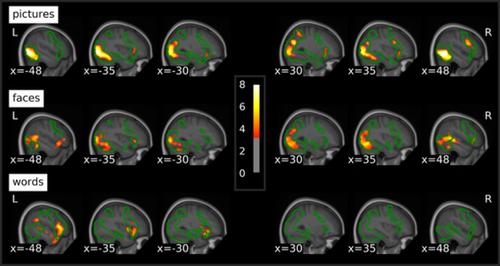当前位置:
X-MOL 学术
›
Hum. Brain Mapp.
›
论文详情
Our official English website, www.x-mol.net, welcomes your
feedback! (Note: you will need to create a separate account there.)
Negative content enhances stimulus-specific cerebral activity during free viewing of pictures, faces, and words.
Human Brain Mapping ( IF 3.5 ) Pub Date : 2020-07-07 , DOI: 10.1002/hbm.25128 Lea Marie Reisch 1, 2 , Martin Wegrzyn 1 , Friedrich G Woermann 2 , Christian G Bien 2 , Johanna Kissler 1
Human Brain Mapping ( IF 3.5 ) Pub Date : 2020-07-07 , DOI: 10.1002/hbm.25128 Lea Marie Reisch 1, 2 , Martin Wegrzyn 1 , Friedrich G Woermann 2 , Christian G Bien 2 , Johanna Kissler 1
Affiliation

|
Negative visual stimuli have been found to elicit stronger brain activation than do neutral stimuli. Such emotion effects have been shown for pictures, faces, and words alike, but the literature suggests stimulus‐specific differences regarding locus and lateralization of the activity. In the current functional magnetic resonance imaging study, we directly compared brain responses to passively viewed negative and neutral pictures of complex scenes, faces, and words (nouns) in 43 healthy participants (21 males) varying in age and demographic background. Both negative pictures and faces activated the extrastriate visual cortices of both hemispheres more strongly than neutral ones, but effects were larger and extended more dorsally for pictures, whereas negative faces additionally activated the superior temporal sulci. Negative words differentially activated typical higher‐level language processing areas such as the left inferior frontal and angular gyrus. There were small emotion effects in the amygdala for faces and words, which were both lateralized to the left hemisphere. Although pictures elicited overall the strongest amygdala activity, amygdala response to negative pictures was not significantly stronger than to neutral ones. Across stimulus types, emotion effects converged in the left anterior insula. No gender effects were apparent, but age had a small, stimulus‐specific impact on emotion processing. Our study specifies similarities and differences in effects of negative emotional content on the processing of different types of stimuli, indicating that brain response to negative stimuli is specifically enhanced in areas involved in processing of the respective stimulus type in general and converges across stimuli in the left anterior insula.
中文翻译:

在自由查看图片、面孔和文字时,负面内容会增强特定刺激的大脑活动。
已经发现负性视觉刺激比中性刺激引起更强的大脑激活。这种情绪效应已在图片、面部和类似的文字中显示出来,但文献表明在活动的轨迹和侧化方面存在刺激特异性差异。在当前的功能性磁共振成像研究中,我们直接比较了 43 名年龄和人口背景不同的健康参与者(21 名男性)对被动查看的复杂场景、面孔和单词(名词)的消极和中性图片的大脑反应。负面图片和面孔都比中性的更强烈地激活了两个半球的纹外视觉皮层,但对于图片的影响更大并且更向后延伸,而负面面孔还额外激活了颞上沟。否定词差异激活了典型的高级语言处理区域,例如左额下回和角回。杏仁核对面部和文字有小的情绪影响,它们都偏向左半球。虽然图片总体上引发了最强的杏仁核活动,但杏仁核对负面图片的反应并不明显强于对中性图片的反应。在各种刺激类型中,情绪效应都集中在左前岛叶。没有明显的性别影响,但年龄对情绪处理的刺激特异性影响很小。我们的研究指出了负面情绪内容对不同类型刺激处理的影响的异同,
更新日期:2020-07-07
中文翻译:

在自由查看图片、面孔和文字时,负面内容会增强特定刺激的大脑活动。
已经发现负性视觉刺激比中性刺激引起更强的大脑激活。这种情绪效应已在图片、面部和类似的文字中显示出来,但文献表明在活动的轨迹和侧化方面存在刺激特异性差异。在当前的功能性磁共振成像研究中,我们直接比较了 43 名年龄和人口背景不同的健康参与者(21 名男性)对被动查看的复杂场景、面孔和单词(名词)的消极和中性图片的大脑反应。负面图片和面孔都比中性的更强烈地激活了两个半球的纹外视觉皮层,但对于图片的影响更大并且更向后延伸,而负面面孔还额外激活了颞上沟。否定词差异激活了典型的高级语言处理区域,例如左额下回和角回。杏仁核对面部和文字有小的情绪影响,它们都偏向左半球。虽然图片总体上引发了最强的杏仁核活动,但杏仁核对负面图片的反应并不明显强于对中性图片的反应。在各种刺激类型中,情绪效应都集中在左前岛叶。没有明显的性别影响,但年龄对情绪处理的刺激特异性影响很小。我们的研究指出了负面情绪内容对不同类型刺激处理的影响的异同,











































 京公网安备 11010802027423号
京公网安备 11010802027423号